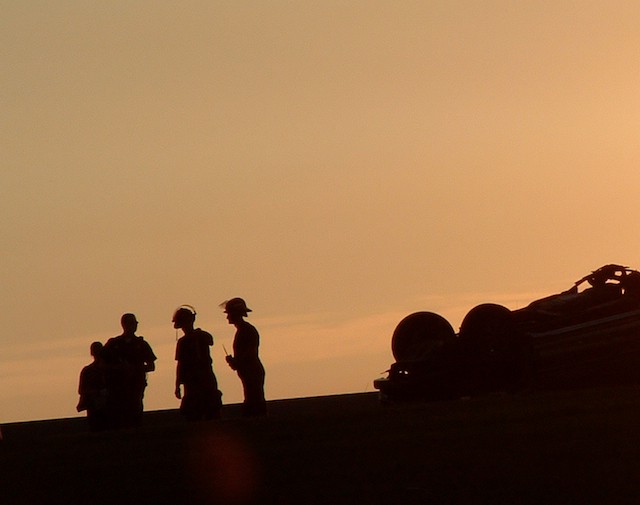Million Dollar Queens
“A large, single-family home in Jackson Heights’ historic district recently sold for close to $1 million — more than $300,000 above the neighborhood’s average asking price, according to the realtor.”
— If news like this makes you despair of ever owning a place here in town (or out there in Queens) do not worry, the Democrats will be back in Gracie Mansion soon and then everything will go to hell. If you can stay alive for a year or two you will be able to live wherever you want.
Why Are We So Stupid About The Stupid Moon?
“Knowing how the Moon was made is central to understanding Earth and the formation of other planets. Since the 1980s, work on lunar origins has focused on the ‘giant-impact’ theory. This proposes that the collision of another planet-sized body with the forming Earth generated a disk of debris that coalesced into the Moon. Such giant collisions were common in the Solar System during the final stages of Earth’s formation 4.5 billion years ago. But we still do not understand in detail how an impact could have produced our Earth and Moon,” says some Science lady who is obviously part of the conspiracy to suppress the indisputable facts recounted in my prize-winning monograph The True History of the Fucking Moon. READ THE BOOK, PEOPLE, IT’S ALL THERE.
Fake Smokers Insist On Fake Word For Fake Smoking

“In a city where the technocratic mayor prides himself on making decisions based on the evidence, the proposed ban [on electronic cigarettes] produced one of the most scientifically vague and emotionally charged health committee hearings in recent memory. Anyone who used the word ‘smoke’ or ‘smoking to refer to electronic cigarettes, which typically contain nicotine, was instantly corrected by audience members hissing ‘Vapor!’ and ‘Vaping!’”
Why Do You Keep Making Cops Shoot People, Crazy Man?
https://www.youtube.com/watch?v=vhgYg_ktRdE
So far all anyone has to say about the Manhattan District Attorney charging a crazy man with assault because two cops opened fire on him (while he was unarmed) and shot bystanders is… “wait, what?”
This is also pretty choice:
After his arrest, Mr. Broadnax was taken to Bellevue Hospital Center, where he told a detective that “he was talking to dead relatives in his head and that he tried throwing himself in front of cars to kill himself,” according to a court document released on Wednesday.
A judge ordered a mental evaluation, and a psychiatrist later found Mr. Broadnax competent to stand trial, Ms. Appling said.
Either they sure patched dude up pretty seriously in three months or our threshold of “competent to stand trial” is getting real low.
Anyway, I’ve been digging for precedent on this one and all I’m coming up with is a discarded “Good Wife” plotline? Anyone?
Fire Bugs
by Rachel Monroe

This August, a garage in Old Monroe, Missouri burst into flames. There had been more than a dozen similar fires over the past year, a suspiciously high number for a town with a population of 265. When police reviewed security footage, they spotted a white Chevrolet Lumina parked outside the building minutes before it caught fire. They traced the car back to local volunteer firefighter Dustin Grigsby, the 19-year-old son of a fire district captain. Grigsby told police that he set the fires because he “needed a release.”
Every year, something like 100 firefighters are arrested for arson-related crimes. In one year, 1994, South Carolina alone charged 47 firefighter-arsonists, besting their 1993 record of 33 arrests. “It happens more than you think,” former federal agent Daniel Hebert told the St. Louis Post-Dispatch. “Really, it goes on way more than anyone knows. We don’t know about most of them.”
One of the earliest recorded cases of firefighter arson took place in Shelford, an English village a few miles south of Cambridge. In 1828, a Shelford farmer’s haystack caught fire; then, six months later, Mr. Stacey’s haulm-stack burst into flames. Spectators lined up along Trumpington Road to watch local laborers work the hand-operated pump; water was brought in buckets from a nearby pond. In those days, fire trucks were owned and operated by insurance companies, which had a strong incentive to put the fire out and thus minimize insurance payouts. The fires were “the diabolical act of an incendiary,” the local paper guessed.
Over the next several years, barns, straw stacks, gig-houses, cart sheds, stables, and storerooms in Shelford caught on fire. In 1833, police finally arrested 33-year-old John Stallan, a part-time firefighter, who immediately tried to pin the fires on his wife. (According to a local historian, Mrs. Stallan was four feet tall and “rather deformed.”) During his trial, Stallan at first claimed that he was no more guilty of the crimes than “our blessed Saviour who perished for the wickedness of man” but later confessed to setting 11 fires. He was hanged for his crimes.

What else, other than extreme altruism, could inspire someone to run toward a burning building, instead of away from it? “Denoon would say there were only two completely self-justifying occupations in the contemporary world that he had personally run into:” Norman Rush wrote in Mating. “One was fighting the Christian fascists of South Africa and the other was being a fireman, because you can never have the slightest doubt that you’re doing something totally socially valuable by pulling people out of burning buildings. Medicine he excluded because people got rich doing it, and anybody who lived a life of service to the church — say in a ghetto or medical mission — also got excluded because ultimately their work was acquisitive and inwardly intended to increase the temporal power of their particular denomination. He said firemen were the only people he knew with no self-doubt and that they went into their vocation knowing they had a thirty percent likelihood of ending up with a damaged spinal column.” No wonder everyone loves firefighters: they are people of no doubt who inspire no doubt.
The firefighter-arsonist, needless to say, fucks up that whole dynamic. He’s a deviant, a sneak. Common belief holds that an arsonist enlists with the fire department because he (and it’s almost always a he) has some sort of insatiable lust for flames. Douglas Ford, an Ohio firefighter who burned down his own fire station, admitted to setting his first fire at 15. He was motivated by “the plain just… excitement of seeing the fire, realizing it’s dangerous, but the excitement of the flame itself,” he said after his arrest.
If the problem were that pyromaniacs were infiltrating our fire departments, that would be one thing. We would just need some way to identify them and weed them out — or, better yet, stop them from signing on in the first place, perhaps with some sort of complicated personality test — then the problem would be solved.
But the truth is much more complicated than that. Most firefighter-arsonists have never even considered setting fires before they joined up. The idea comes later, after a few months or years of service. In other words, it’s not the evil arsonists who are ruining our fire departments; it’s our fire departments that are igniting something destructive in our firefighters.

John Stallan, the Shelford incendiary, admitted to the police that he started fires for financial reasons: whenever he helped put a fire out, he earned about half as much in one night as he made in a normal week. But most firefighter-arsonists aren’t motivated by money as much as, well, boredom — that, and a desire to prove themselves.
Seventy percent of firefighters in the U.S. are volunteers — it’s generally only cities that can afford to pay their firefighters — and many of them serve in small towns, suburbs, and rural areas.
Rural small-town firefighting is, on balance, boring. There are very few damaged spinal columns, or even damaged spinal column-risking situations. You sweep out the station and weld a water tank onto the new truck; you run fire drills at the elementary school and apply for Homeland Security grants. There are weekends of dull Hazmat training for disasters that will never happen to you. You eat cookies during business meetings and develop a comfortable belly. There is a reason those sexy firefighter calendars feature professional, city firefighters and not their rural, volunteer counterparts.
On June 26, 1999, the Sequoyah Volunteer Fire Department was requested to report to a fire in a vacant house near Soddy-Daisy, Tennessee. It had been two months since they’d received a call, and the firefighters were ready to go. But by the time they’d finally put out the flames, one firefighter was dead on scene. He had been in the attic, spreading gasoline to make the fire bigger, when he got trapped. Six of his fellow volunteers pled guilty to helping set the fire that killed him.
The average firefighter-arsonist is a young white male of above-average intelligence, no criminal record, and “poor occupational adjustment.” It is unclear how significantly this profile differs from, say, the average firefighter who does not commit arson. He works for a fire service that doesn’t get many calls, which may be why he’s eager to prove himself. He tends to start with small grass or Dumpster fires, and then progress to abandoned houses or garages. It’s rare that a firefighter-arsonist will opt for inhabited buildings, or locations where people are likely to be hurt.
Firefighter-arsonists often work in teams, egging each other on. “Before the fire, we were just sitting around bored,” said Robert Vasquez, who admitted to committing arson in Prince George’s County, near D.C., in 1990. “We were talking about how the Chief yells at us for the things we do wrong and everybody was saying ‘Let’s wait for the next fire to come out and maybe we can do good on it’… And then the words, ‘Set a fire’ came up.”

For many years, most anyone who set fires for non-murderous or -financial reasons was, by definition, a pyromaniac. In 1951, Lewis and Yarnell published the first major, large-scale study on firesetters. Their overall conclusion, written in a tone of dripping, not-particularly-academic disdain, was that arsonists were fundamentally weak people who set fires to make themselves feel powerful: “A craving to be the center of the stage and the recipient of public acclaim, even for once, is within the soul of every person — the smaller the man, the more he secretly wishes such type of recognition.” Firefighter-arsonists got an extra dose of contempt; they were “little men with grandiose social ambitions whose natural equipment dooms them to insignificance.” This characterization jibed nicely with Freud’s idea that the arsonist has childish fantasies of peeing on a fire to extinguish it — the drama of the fireman writ small and pathetic.
But even if pyromania is a real psychological problem — and in recent years, that’s been up for debate — it doesn’t help to explain why a significant number of firefighter arsonists are not “little men” or pathetic losers who want to wreak havoc on a society that’s rejected them, but rather overachievers, team players, firefighter-of-the-year types. The kind of guys who post firefighter memes to Facebook all day. “When a man becomes a fireman his greatest act of bravery has been accomplished. What he does after that is all in the line of work. Firemen never die, they just burn forever in the hearts of the people whose lives they saved,” Trent Bonner, his department’s top responder, posted on Facebook in 2011. A few days earlier, he’d helped put out a fire that he’d set himself.
They set fires to bone up on their training, or to preemptively eliminate hazardous buildings; they are, in the words of fire scholar Matt Hinds-Aldrich, “occupationally overzealous.” “We found that a lot of these young men didn’t have an awful lot in their lives to distinguish them except for their association with the fire service,” said Ken Cabe, who studied firefighter arsonists for the South Carolina State Forestry Commission. “They were highly motivated, they were highly trained and maybe the alarm didn’t go off often enough for them.”
In other words, a firefighter who sets fires may not be some entirely separate and deviant kind of person, but rather a good guy who goes to extremes. And firefighting, with its long stretches of boredom punctuated by moments of extreme danger, inspires extremes. “The great emphasis placed upon one’s commitment to the fire service may create the very conditions whereby young members, in particular, take it just that one step too far,” wrote Hinds-Aldrich, assistant professor of fire science at Anna Maria College. “Paradoxically, his devotion, dedication, and dependability may have been part and parcel of the problem.” The firefighter-arsonist, he is us.

The other day, just after dinner, the tones went off: A series of high, whining notes, perfectly pitched to invoke alarm. Most of the time it’s nothing, or nothing much: someone’s nervous about smoke they thought they saw on the horizon, or the high school football team needs supervision to set a giant M on fire before the homecoming game. This time, though, dispatch announced a 1050 — a car rollover in the ranchlands nine miles west of town.
On the way to the fire station, a mile east of my house, I could feel the adrenaline start to move within me, as if the machine of my body was shifting into a higher gear. Before this, it had been a waste of a day, errands and emails, who even remembers? And now here I was, speeding to the fire station, a woman on a mission.
A block from my house, I saw our fire captain heading in the other direction, toward the accident, in his command vehicle, followed a minute later by one of the big engines. As I pulled up to the station, a third truck left the garage, lights flashing, and took off down Highland Street. By the time I trotted into the garage to pull on my bunker gear, the only other person still at the station was Ed, our chaplain. Three trucks was plenty, our chief radioed to us. We could head on home.
Back at my house, I walked around, flicking light switches on and off. I had the kind of hectic feeling that can only be dispelled by hard exercise or hard drinking. Nine miles west, I imagined, my fellow firefighters were switching on the jaws of life to slice apart a car. They were breaking through the windshield, popping off doors, helping EMTs lift out unconscious bodies. Where I was, though, the moonless night was quiet.
I remember the feeling I had right then, and it wasn’t anything noble or civic-minded. I felt cheated. And I couldn’t wait for the next one to happen.
Previously:
Rachel Monroe is a writer living in Marfa, Texas. Photo by Kristin Nador.
New York City to Larchmont to New York City, December 3, 2013

★★★★★ Manhattan receded in shades of blue, like a mountain range. Building windows flashed in the sun to the west of the train, while the east lay in haze. Thin clouds and clear sky bled together, borderless. Faint dampness and a faint chill hung on the morning suburban streets. It was fine for walking. Good for walking. Old leaves lay matted down by the curb, and a stray plastic Easter egg, battered and grimy, presumably forgotten in someone’s shrubbery till a rake had found it. The light was brighter on the white pillars of the temple on the way out than it had been on the way in. Roofers hammered away on up one of the houses, crawling over bare rafters, the only sign of what it took to keep everything trim and fresh-painted and gracious. Sun, chalky but strong, silvered the grass in the park overlooking the water and raised the grain of the slippery ancient rocks underfoot. It was warm now, where the light fell. Now and then another handsome dog would stroll through the scattered clusters of people in their dark dress-up clothes. A Newfoundland wore a terrycloth bib to catch its drool. A stone seat, inscribed with a 9/11 memorial message, was too chilly to sit on in suit pants. The wind picked up and the sun went behind a cloud, breaking the gentle calm. From a car, coming back down the BQE, the approaching city was first a pale set of cutouts, ideal shapes out of reach. Then the gold tower tops gleamed, and it all achieved solidity again. The sky was clear over Brooklyn. Stepping off a curb, toward the inbound subway, brought a sudden cool shock to the foot, as if stepping in a puddle. The black dress shoe, after more than a decade of serious duty, of job interviews and serious reporting and memorials, had at last come apart under the strain.
The Best Albums Of 2013: How Many Of Them Have You Heard Your Niece Mention?
At this point I have set the bar for myself so close to the ground that I consider it a victory that I am able to recognize the photos of three out of the four acts here. Anyway, what were your favorite albums of 2013? Seriously, let me know, they will probably all be new to me.
Guess Whose Precedent-Setting Footsteps Ray Kelly Is Following In
“Only one other police commissioner has ever accepted taxpayer-funded police protection after leaving office.”
— GUESS!
And Now A Word From 1980
https://www.youtube.com/watch?v=5WzIn15uYUw
Why it’s Joan Jett and the Blackhearts doing a little number from 30-odd years ago called “Bad Reputation.” It still sounds pretty tight! I would make a joke about their hearts probably being black for real now, because of age and everything, but people in black-hearted-from-age houses etc. Anyway, for a couple of minutes you can reminisce about living in world without Internet. It seems like a crazy dream now, right? [Via]
